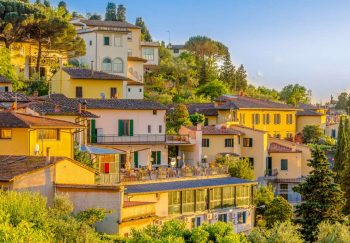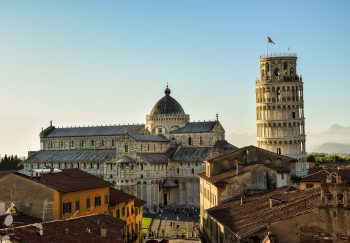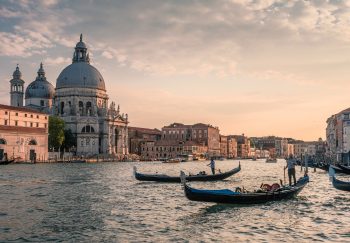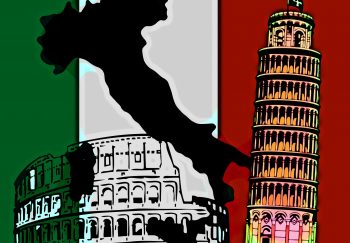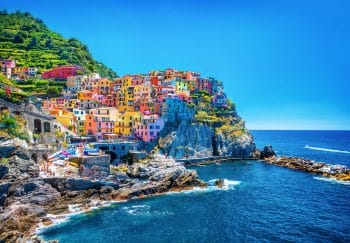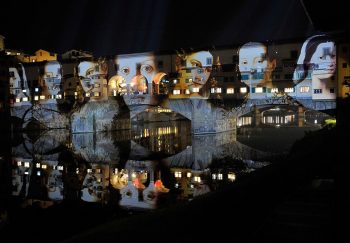I’m not religious at all. Yet, I find churches to be some of my favourite places when I travel through Italy. These sacred spaces are a treasure trove of art and history. They can also inspire strong emotions, even from people with different beliefs. I am always amazed at the dedication of those who built historic churches. It is amazing to see how much they believed in the structure and why they chose to build it. Although I am an atheist I do respect devotion.
I’m not a historian either. When I travel to Italy, I cannot get enough of the remnants from bygone eras. These can be ancient ruins or palaces which were once home to a noble family but are now offices or apartments. The current of all those who have gone before me, those who lived or worked in these spaces, is like a tangible wire that connects me to the past. Being born in such a young nation, it’s an incredible feeling to be able to walk on the same cobblestones thousands of years later.
The topic for this month’s Italy Roundtable is MOVED. As you can see, I am deeply moved by Italy’s history as well as its churches. It can be overwhelming when these two things are combined.
This is especially true when I think about the journey that brought me here.
The first time I went to Prague, in 1992, it was relatively-newly-liberated from Soviet rule – Czechoslovakia was still one country. My Swiss cousin was with me. Her native German and a few Russian words proved to be invaluable – there were very few English-speaking people we met.
I don’t know how we came upon the old Jewish quarter.
Walking through the Jewish cemetery was something I remember. There were bodies buried up to 12 layers deep due to the lack of space. Jews were not allowed expand their cemeteries. The profusion of gravestones piled up at awkward angles and with many rocks resting on top, in keeping with Jewish tradition, is something I recall. I remember seeing the beautifully-preserved synagogues, marveling at the ornate interior of the Spanish Synagogue and the austere facade of the 13th-century Old-New Synagogue.
Then I recall my stomach buckling as I realized that these historical monuments were the only reason I could still see them today. Hitler wanted the neighborhood to be preserved as a museum for his extinct race.
We can thank Hitler for saving Prague’s Jewish quarter.
For a moment, let that sink in.
I must admit that I was disappointed when I first walked into the Roman Forum.
It’s difficult for me to see what isn’t there. This is especially true when it comes to ancient temple ruins. Although I was able to find a great tour guide and had purchased Rome Past and Present, which has many helpful graphic overlays, it was still difficult for me to see that area of broken columns and rock piles as the epicenter the once-mighty Roman Empire.
That Forum had one bright spot was the Curia Julia, the Senate building. Some of it looks almost exactly the same as it did in the 1st Century BCE. I was able to see the floor of ancient Roman buildings by peering into the room, even though you weren’t allowed in it.
Then I walked into Pantheon and almost wept.
In my opinion, there is no such thing as “seeing Pantheon too often”. In the span of 10 days, I visited the Pantheon on four occasions during my last Italy trip. Without a doubt, the Pantheon is my favorite building in Rome . It is also a serious contender to the “all Italy” top spot. Because there is nothing more moving than walking (almost literally!) in the footsteps ancients, it is the best thing about Rome .
Pantheon || photo by Jessica Spiegel, all rights reserved
Although the Pantheon looks different today than it did in its original form, it is still a great place to imagine ancient Rome.
Just thinking about the number of feet that have walked across that floor in the past two millennia can bring a lump to my throat almost every time I stand beneath that perfect dome.
Why did the Pantheon and Curia Julia survive for so many centuries? They didn’t become easy quarries, like many nearby structures, including the Colosseum which we now consider sacred. These buildings were not marvels of the universe back then. They were simply unused and decaying monuments that people were skilled recyclers. In modern buildings all across Italy, you’ll often find an ancient stone. The Curia Julia and Pantheon were not affected. Why?
Both were Christian churches because they were consecrated in both cases.
In the 7th century CE, the Curia Julia was transformed into the Basilica of Sant’Adriano al Foro. It was deconsecrated by the 1930s, and it is no longer a Church. However, the wisdom of conserving ancient monuments was not in question at that time. Built in the 2nd Century CE, the Pantheon was consecrated the Church of St. Mary and the Martyrs early in the 7th century CE. It is still a church. While modifications were made to existing monuments – for example, the Pantheon contains apses that weren’t originally built – consecrating an already existing structure saved early Christians the labor of building new structures.
This is where the story gets interesting: Christianity was not legal in Rome up to the 4th Century CE. Before that, Christians in Rome were often arrested and executed in large numbers. Constantine, the Roman Emperor converted to Christianity in 313 CE. This did not stop the executions and arrests of Christians. It also meant that Christianity was the only legal religion in Rome at the end of the century.
This anti-paganism also meant that temples had to be demolished. Except that they were no longer considered temples.
We can also thank Christianity for some of the preserved Roman buildings.
Ancient Romans didn’t treasure all of their monuments. In the 6th century, the Colosseum’s center was used as a burial ground. These arches became homes and businesses and were used up to the 12th Century. You can see that the outer ring served a similar defense purpose as a city walls. The brick and marble from the great amphitheater was reused by Romans for their houses. When they moved out of the small, walled city, they took the building blocks with them.
It was Christians who were able to enter the Pantheon and make it a church. They gave it to a religion that moved them so much that they opted to endure years of persecution than return to their old gods. Although I don’t believe that the god they were so inspired by, I am grateful that they believed so that I can walk into the Pantheon and feel the emotion.
It’s difficult for me to forgive the early Christians. However, they did the same to the pagan people what they had done for so many years. I do understand their motivation. Hitler’s motivation to preserve Prague’s Jewish quarter was clearly much darker than mine and it is impossible for me to understand his actions.
Also, it must be noted that Prague’s Jews did not leave their cemeteries and synagogues to flee their homes. They weren’t reusing building materials from old monuments to build new apartments. The braid is finished at this point. These two realities were far too divergent.
These things are still there today because of the intervention of two outside groups, one in Prague and one at ancient Rome. These structures are still standing. The history is still alive.
Because of this, light can enter.
We can bear witness but we must also bear witness to all the circumstances that brought us here – and move.
Italy Roundtable: Other Voices
What is the Italy Roundtable’s latest topic? Follow me to each post. Please leave comments and share with your friends. Tune in next month to see another topic from the Italy Blogging Roundtable!
- ArtTrav My Annual Budget
- At Home in Tuscany –
- Bleeding Espresso – 10 Dos and Don’ts for Moving to Calabria
- Brigolante –
-
Ciao Amalfi –
- Driving like a Maniac
- Girl In Florence Why Not Moving To Florence?
- Italofile Before You Consider a Move to Italy. Check This Quality of Life Index
Are we connected?
Are you LIKING us on Facebook? Are you following our Twitter? We’re very friendly, so please drop by to say hello. We are always open to suggestions for future topics for the Italy Blogger Roundtable. Drop us a message on Facebook, Twitter, or comment on any of our posts.
